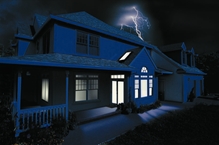What Is Backup Power?

Blackouts. Brownouts. Thunderstorms. Snow & sleet. Ice storms. Floods. High winds. Whether it's caused by a utility power interruption or weather disasters, power outages are frequent occurrences throughout the country.
Buying a generator for standby power can be the first step to regaining control over protecting your family and possessions from harm. And, using a generator is as simple as operating any household appliance. After you have selected a generator, here are a few tips that can help you keep power through the storm.
Consider Your Connection Method
Connecting your generator to your home can be as simple as plugging in a tool or appliance. The difficulty comes in when you want to run items that are hard wired to your homes electrical system such as a furnace fan, lighting and a water pump. Consider these three options:
- Extension Cords - Extension cords are the most common method for powering appliances in your home. Simply plug the cord into your generator and run it through an open door or window to the item you wish to power. Careful not to overload the extension cord. Always use at least 10–12 gauge cord and try to limit the length to under 100 feet.
- Extenda-Panel Extension Cord - This convenient cord combines 4 heavy duty extension cords into one - eliminating the tangle of multiple extension cords. This cord plugs into your 30 amp, 240v receptacle on your generator and delivers up to 7200 watts through 4 different receptacles.
- Power Transfer System - A Power Transfer System is a must if you plan to use your portable generator to operate appliances hard wired to you home's electrical system. This system is the safer, faster and more convenient way to power up to 10 household circuits for up to 7200 watts of power. Comes with a power cord and inlet box that mounts outside your home, eliminating all open doors and windows.

